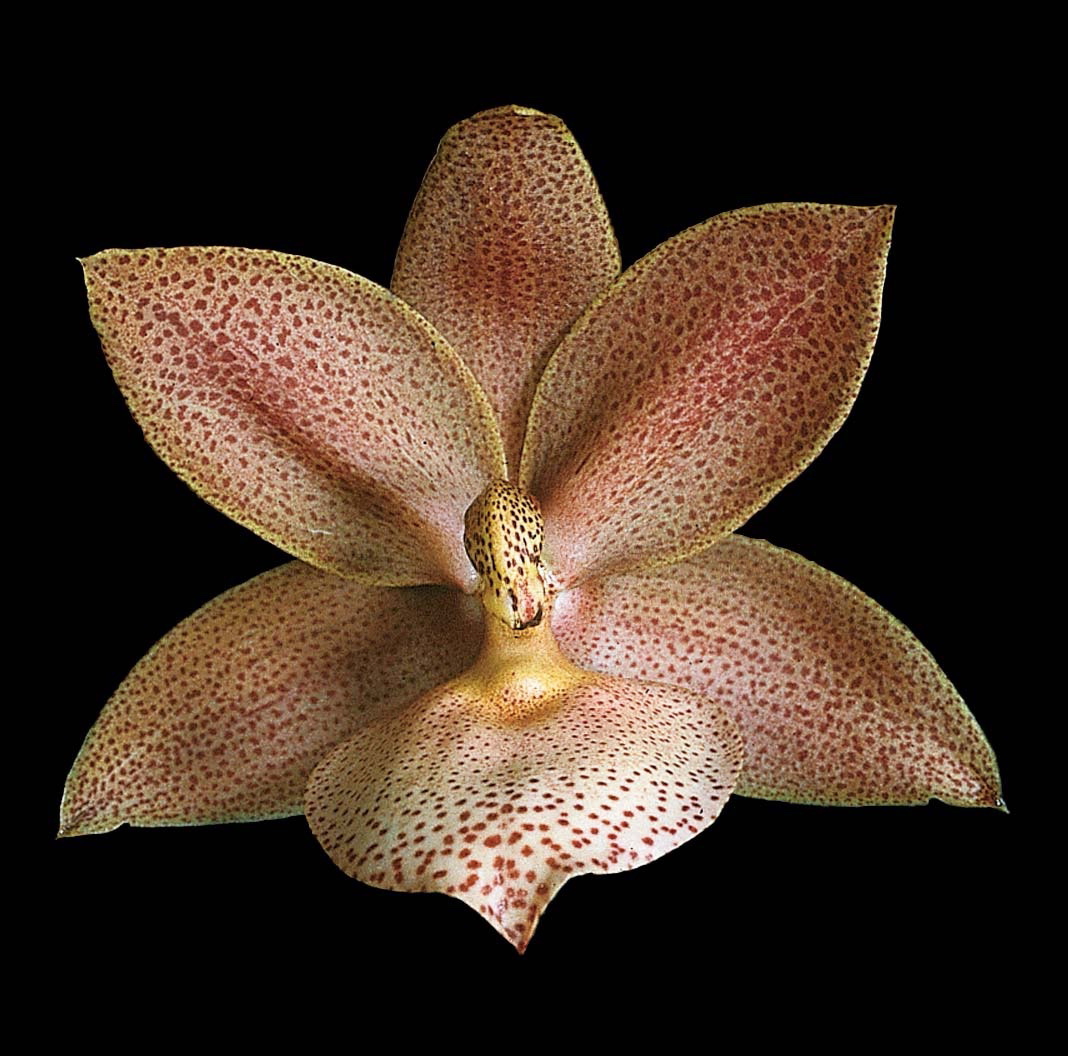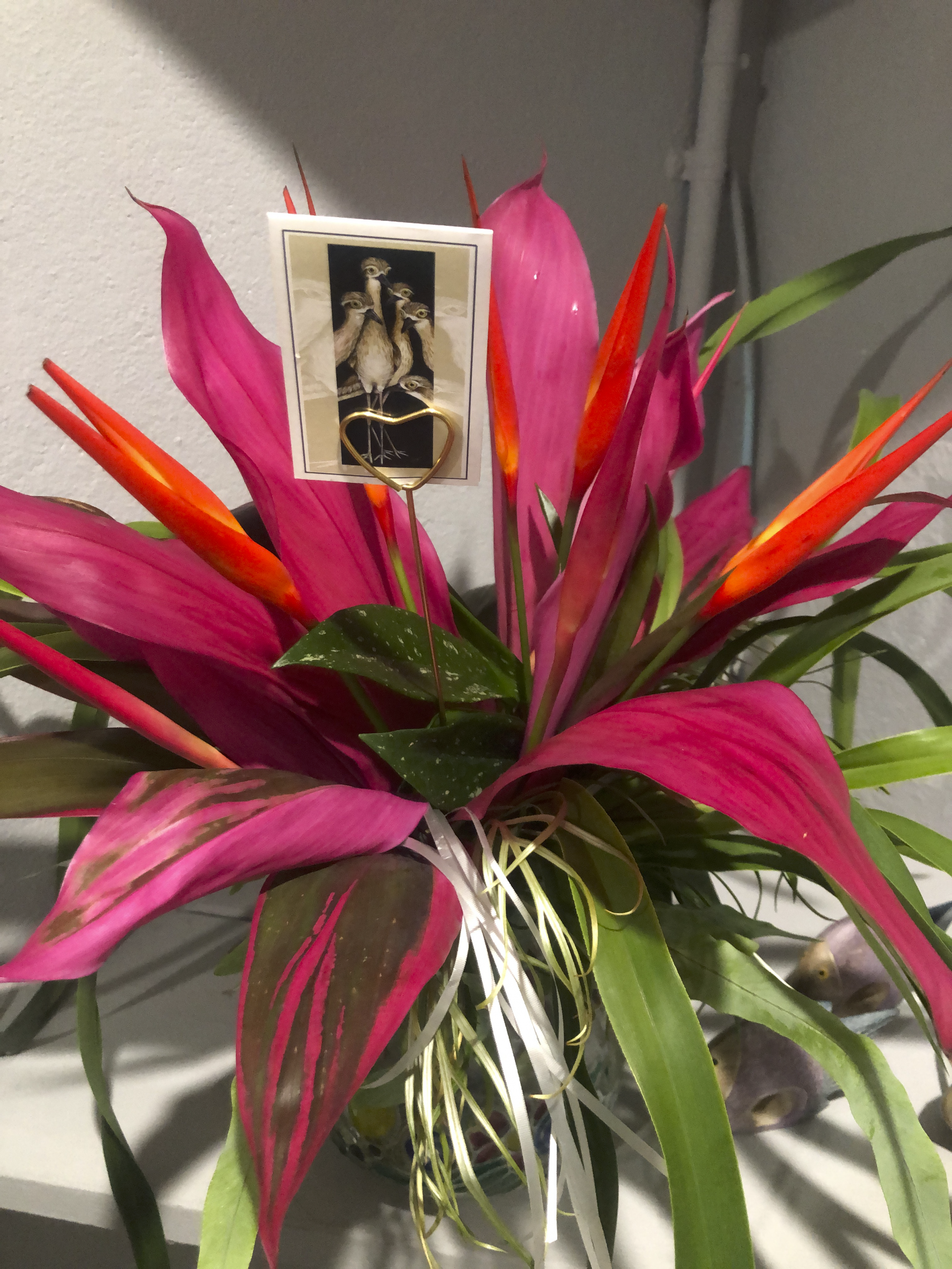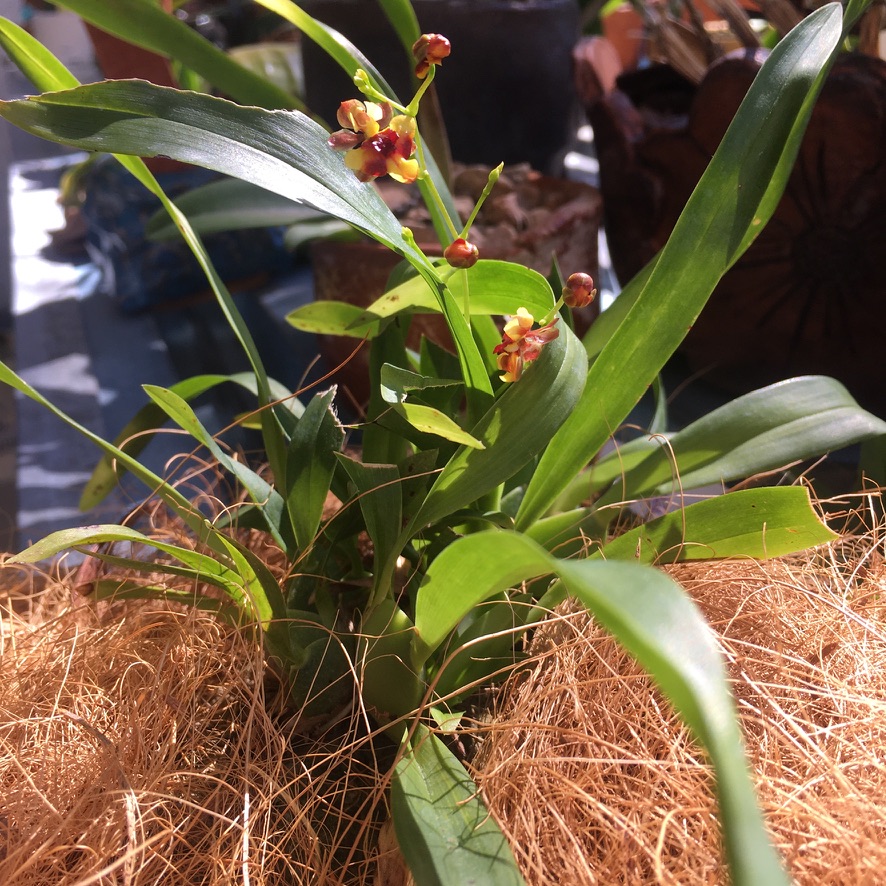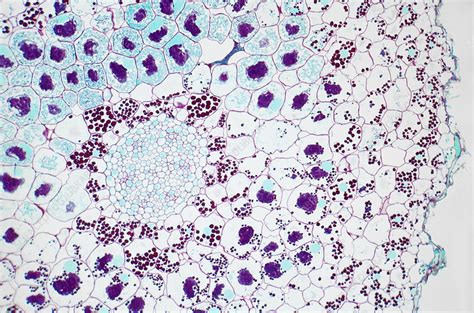Susan Fairbairn caught up with Californian, Fred Clarke, at the Australian Orchid Council Conference (AOCC) 2022 to learn about the latest intergeneric breeding trends using the orchid family: Catasetinae.
Fred is one of the leaders in the field of complex trigeneric breeding and has his own Catasetinae genus called ‘Fredclarkeara’ (Fdk).
Fred started breeding Cattleyas, Australian native Dendrobiums and Paphiopedilums.
orchids over 48 years ago.
He was responsible for many new mini Cattleya hybrids (mini catts).
![Fred Clarke at AOCC 2022 in front of the display by [] Photo (c) Susan Fairbairn](https://littleflower.business/wp-content/uploads/2022/12/Fred-Clarke-C-Little-Flower-dot-business-914x1024.jpeg)
While he still breeds these genera when I asked, why the change? He said, “breeders are creatives and, like painters, we don’t want to paint the same thing over and over.”
According to an article in the “Orchids” magazine (AOS bulletin) he saw an ad by JEM Orchids selling a mix of Catasetinae orchids for “five plants for the price of four.”
He bought the plants in spring, and they grew well, until autumn, when they dropped all their leaves.
“I got worried, so I began reading about this family and [I] learned how they had a need for a winter dry dormancy and that, to my relief, leaf drop was normal.”
The following season; in late summer, the plants began blooming.
“The flower colour, shapes and fragrances were like none I had ever seen before.”
And that, combined with the seasonal changes, made me realise these plants were for me.
“One of those original plants, gave me my first FCC.” (1)

An FCC is a First Class Certificate awarded by the American Orchid Society (AOS) for a plant that scores <90 out of 100 against certain judging criteria.
Fred is an accredited AOS Judge in the Pacific South judging region.
Catasetinae
These orchids gave Fred the opportunites, and, the challenges of trigeneric breeding.
Fred didn’t mind the challenges, he was more interested in the opportunities; the opportunity to learn more about orchids which he says, “…..is the best part.”
Catasetums, Mormodes, Clowesia, Cycnoches and various hybrids are all part of Catasetinae and they have, until more recently, been less popular with hobby orchidists, but Fred saw potential for something more mainstream and perhaps commercial, meaning that he thought it was a “good hobbyist plant”.
The World Checklist of Monocotyledons recognizes 64 Catasetum species and 9 natural hybrids (2007). Wikipedia says there are more like 200.
That’s a few plants with which a breeder can work their magic.
Another challenge for breeding Catasetums is that they are florally dimorphic and dioecious. While dioecy in angiosperms means separate male and a female plants, in rare cases, in Catasetums, you can have female and male flowers on one plant on separate inflorescences, and sometimes on the same inflorescence. They can also carry hermaphrodite flowers.
The female Catasetum flowers last for five to ten weeks. The male flowers less.
“It’s the male flowers that are generally the showiest and they flower at different times so you have to save pollen,” says Fred.
They also have specialised pollinators; Euglossini bees, also known as orchid bees.
“One of the funniest things in the greenhouse is to watch the expression of an unsuspecting [bee] guest when he or she triggers the pollinia and it shoots out from the flower.
“These flowering habits and traits are unusual, adding to the intrigue.”
Some of the species that Fred has used as pollen or parent plant include Ctsm pileatum with the largest flowers (male) some 13 cm across. He has used Ctsm expansum, and Ctsm tenebrosum the latter is a dark black orchid with contrasting chartreuse labellelum.
And, the species Ctsm spitzii, which also has very large flowers, with 30 or 40 flowers on an inflorescence.
This created some beautiful cultivars Ctsm. spitzii ‘SVO Burnished Gold’ (2018) Ctsm. spitzii ‘SVO Gold’ (2015) and Ctsm. spitzii ‘J.E.M.’ (1999).
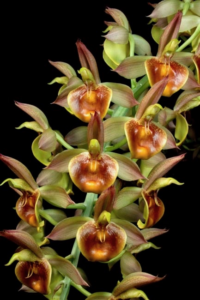
The species Ctsm denticulatum was used to reduce vegetative size and resulted in the following awarded varieties. (2) Ctsm. denticulatum ‘Sunset Valley Orchids II’ (2008)
Ctsm. denticulatum ‘Sunset Valley Orchids’ (2003) AND Ctsm. denticulatum ‘Little One’ (1997)
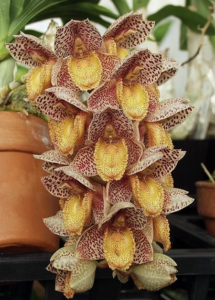
The pièce de résistance came with a cross between Ctsm. Donna Wise ‘Kathleen’ (AM/AOS) x Mormonde Painted Desert ‘Sunset Valley Orchids’ HCC/ AOS which led to the development of the famous grex, Fredclarkeara After Dark, ’SVO Black Pearl’ (3)
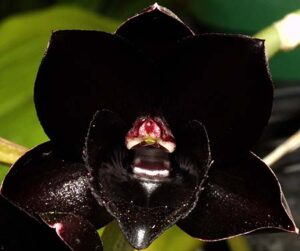
“Is it black?
“If your eyes says its black then it’s black right?” says Fred.
This orchid has received over 100 awards worldwide with nine FCC’s and thirty Award of Merit (AM) from the AOS judges.
A fertile clone will set you back a cool $US1,000.00.
Another bonus of these orchids is the perfume and in fact Jim Ford was so inspired he created the perfume ‘Black Orchid’ The flowers are said to have a spicy sweet fragrance.
Then the same cross above produced these spotted gems below:

This breeding led to other dark and wine coloured orchids in the FredClarkeara After Dark lines including hybrids: ‘After Dark’ ‘After Hours’ ‘After Midnight’ and ‘Alexa’s Raspberries’.
One hybrid ‘black cherry’ with a deep cherry red flower, produced 107 flowers on 4 inflorescences.
“You know you’ve made it in life when there’s a slot machine in Vegas called black orchid,”says Fred.
These dark orchid flowers were exquisite and put Fred and his nursery Sunset Valley Orchids on the map.
There are 54 registered Fredclarkeara hybrids as of May 2020. “But how many black orchids can you have? “So how about green with picot markings? Or something else?
A cross between Mormodes Painted Desert x Ctsm. Susan Fuchs resulted in Fdk No doubt with candy pink coloured petals and sepals and, yes, picot markings.
“Look at the shape how full the petals are how broad the lip is; the arrangement —its perfect.”
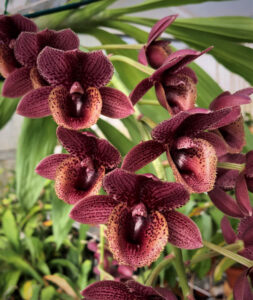
Take that cross and make another with Ctsm Everglade and voila: Fdk Doubtless comes along with the green background and picot markings.
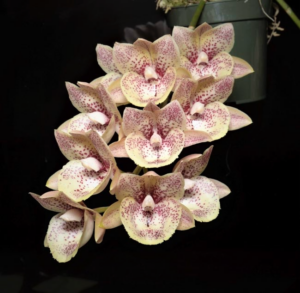
But if you want a flat green then cross (Mo. Lime Tiger x Ctsm. expansum) and: ‘FDK Turning Point’.
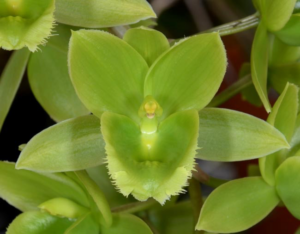
How about more frilly lips? Ctsm Dentigrianum a grex created by crossing denticulatum x tigrinum
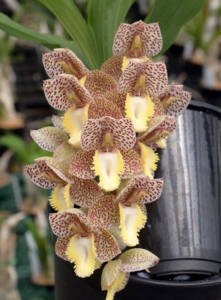
Now……lets try some things with Cycnoches.
According to Fred this genera has had three new species introduced to cultivation. The dramatic swan shaped flowers are the reason he became so enamoured with this family.
So, “How do you pronounce it? “Seek no cheese?” No. “Sik no keys”
These orchids, like Catasetums, are dioecious and sexually dimorphic and as Fred says,
“That’s fun to say.”

Cycnoches male flowers have long slender columns. The females look similar but have a shorter stem and no pollinia. They do have a rostellum.
The flowers of all Cycnoches species are non-resupinate (flowers are upside down with the lip pointed upward) and fragrant many have a pine like scent. Bloom longevity is generally 3-4 weeks.
“These orchids are easy to grow and have beautiful foliage. “And did I mention they make great hobbyists plants!,”
The Cycnoches genus have two sub-genera sections:
● Eucycnoches–few but larger orchid blooms.
● Heteranthae–smaller but thicker raceme inflorescences.
In a supplement titled “Hybridisers’ produced by the AOS October 2022, written by Fred, he says Cyc. warszewiczii today is full and flat because of extensive line breeding that has improved the flower shape.
Cyc cooperii is a favourite with its one metre long flower stems that can have 30 or more flowers.

Cyc. cooperi ‘Mem Pat Worthington‘ has been used many times in crosses due to its beautiful coloured flowers.
The cultivar Cyc Cooperi ’SVO’ had 47 flowers on a one metre inflorescence. One day he hopes for a green Cyc Cooperi x.
Then we have an unusual species from Columbia Cyc barthiorum which Fred says is floriferous.
“I would like to give this one to the student judge and get him to describe the colours.”

The species Cyc herrenhusanum is a chartreuse yellow and again male and female flowers are different. The rostellum (the piece of tissue that separates the stigma from the pollen to prevent self pollination) has a gap in this species.
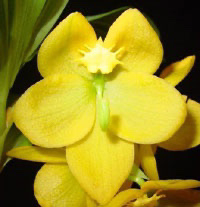
Some of the Cynoches primary hybrids include Cyc Jean E Monnier (Cooperi x barthiorum)
This grex says Fred has been successful. It has been given 29 AOS awards, including 18 AM/AOS. The faults have been minimised and it produces beautifully coloured, well shaped, and nicely arranged flowers.
Using Cyc herrenhusanum and crossing it with Cyc warscewiczii you get Cyc Kevin Clarke and a nice cultivar: Cyc. Kevin Clarke ‘Gold Spots’
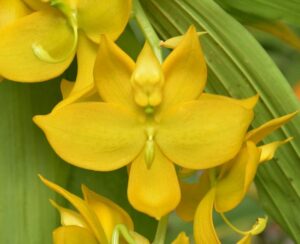
Fred was looking for red flowers and when Cyc Martha Clarke flowered, it was tangerine.
“I’m ok with that.”

Cyc Richard Brandon was made in 2011. It’s a cross of Cyc. warscewiczii x Cyc. Jean E. Monnier.
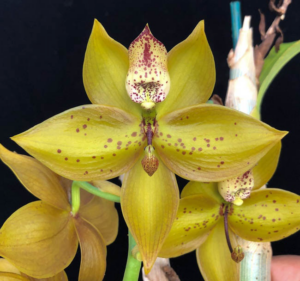
Persistence paid off and Fred says of Cyc Providence ‘SVO’
“Bloody hell we are only three generations deep into breeding and is that an FCC bold spotting on the background?”.

Fred, the painter, turned his gaze to the Mormodes.
Mormodes
Mormodes: the goblin orchid, named because of the unusual attachment of the column and lip.
The World Monocot Checklist contains 81 accepted species names (9/2007).
“Mormodes are usually considered to bear perfect or bisexual flowers with both pollen and a stigma in the column.
Like Clowesia and Dressleria, however, the stigma will not accept fertilisation until the pollen has been removed. After the pollen is removed, the column straightens and raises back to expose the stigma for pollination.
A vegetative feature that distinguishes Mormodes from the other Catasetinae is that the inflorescences generally originate from the middle or lower nodes of the pseudobulbs.
Another difference from the other Catasetinae is that the inflorescences of Mormodes project straight out or upward from the pseudobulb.
Some Mormodes species produce different types of flowers referred to as female-dominant, male-dominant and normal hermaphroditic or bisexual flowers. This variation in flower shapes and sizes on the same species has confused the identification of many species.
There are also indications that a few species do produce on occasion small male flowers with only pollen and a vestigial stigma.
The so-called female-dominate flowers are larger and heavier than the male- dominant or normal bisexual flowers. Although the flower has pollen, it probably would function well only as the recipient of pollen from another flower.” (George Carr AOS.org)
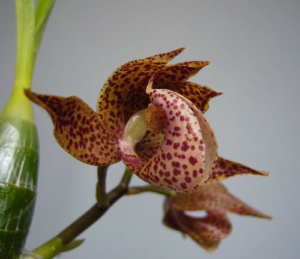
Fred says he started out with Morm. Lawrenciana which has a saddle shape quality to the lip.
“The petals are forward and the sepals go back which doesn’t conform to judging standards.” But never say never and…
Along came Morm. Lawrenciana ’SVO’
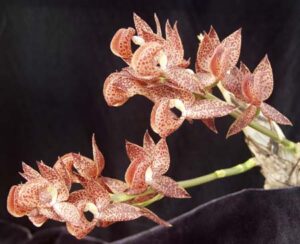
Further breeding gave birth to Morm sinuata ‘Sunset Valley Orchids’ with red striped flowers.
“The shape is not like an orchid flower,” says Fred.
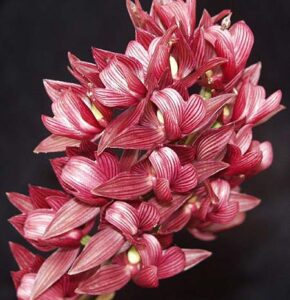
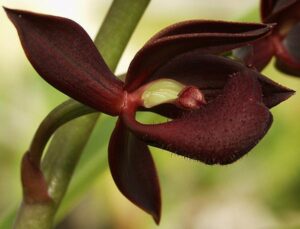
Morm Virgen del Valle– with an interesting backstory
Fred was visiting Venezuela and received an orchid from a man which was a cross between Morm sinuata and Morm Hookeri.
“When it flowered I called him and said I’d like to register it.
He said you bloomed the first one so yes, it’s all fair.
So Fred sent him a registration form with a few different names,
“He [the man] had called it Virgen del Valle which translated means virgin of the valley.
“I had thought of ‘sinful hooker’ because of the cross (Sinuata x Hookeri) but this guy picked out virgin of the valley!”
Fred sent off the registration form with both names and then that night woke up in a hot sweat.
“What’s the registrar going to think of me?
“And if they don’t accept the first name (Virgen del Valle) I have a lot of explaining to do.
This gentlemen visited him down the track and though he didn’t speak much English through the use of simple language Fred gained an insight into his personality.
“So I told him about the names and he started laughing and he said why didn’t you name it sinful hooker?”
“I found out that Virgin of the valley is like saying “oh my gosh”
“It has nothing to do with virgins or valley’s.
“Aren’t orchids the best.”
Back to the nitty gritty and a cross between Virgen del Valle with Morm Nitty Gritty and there was Morm Aftermath.
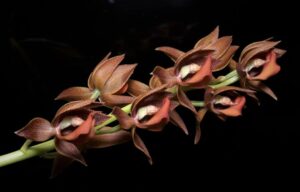
Fred says that crossing Cynoches and Mormodes can give excellent flower size and beautiful and unusual coloured flowers.
“If you have a look at Cycd John Naugle it gives you every judging point for colour.”
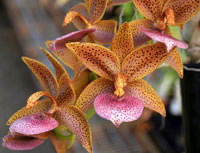
Finally we come full circle to the genera, Clowesia. This genus can be used for shape, multiple inflorescences and flower longevity.
Here we have perfect flowers and a smaller plant. There are 7 species of Clowesia.
- Clowesia warczewiczii
- Clowesia thylaciochila
- Clowesia russelliana
- Clowesia rosea
- Clowesia glaucoglossa
- Clowesia dodsoniana
- Clowesia amazonica
When you cross Clowesia with Mormodes you get Mormodia (Mo)
when its crossed with Catasetum you get Clowesetum (Clo) and perfect flowers.
Clowesia are strong growers and are resistant to rot.
Some of the more interesting (and awarded) crosses to come from this line include: Mo. Barnabas Collins ‘Select’, Mo. Barnabas Collins x Ctsm. Orchidglade and Mo. Jumbo World SVO AM.
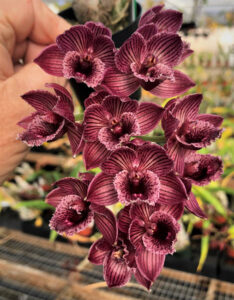

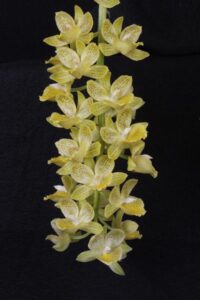
And finally for these crosses: Clowesetum Alexandra Savva ‘Adorable Freckles’ (Cl Rebecca Northen x Ctsm denticulatum) Both parents of this grex are floriferous, small growing plants.
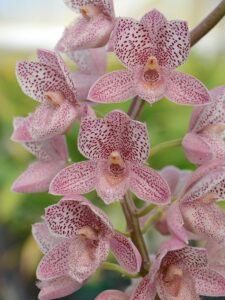
The resulting flower production has been impressive and all of those pink spots make for memorable flowerings. (Fred Clarke in an article for Orchids)
FRED’S TIPS for culture of Catasetinae
- Water like a monsoon
- Use an open well drained media
- Repot and divide with new growth
- Wait to water until the roots are about 5 cm they grow roots in anticipation of rainfall.
- Temperatures: High: 26c to 35c– Low: 16c – 24c
- high light
- Lots of humidity
- Dormant period—neglect, no water.
To break dormancy wait for new growth to get to 3 to 6 inches long then water, “like a monsoon”.
“You can go out and water once a week and they are twice as big…..”
Use fertiliser at every watering at the rate of 1/2 tsp to four litres of water and stop fertilising and watering from June to July until spring.
Fred Clarke
FRED’S SELECTIONS
If you are into species, I recommend trying Catasetum pileatum, Catasetum tenebrosum, Cycnoches warscewiczii, Cycnoches cooperi, Cycnoches barthiorum and Clowesia russelianum.
And if hybrids are of interest, then good choices would be Catasetum Orchidglade (pileatum × expansum), Catasetum Donna Wise (tenebrosum × Orchidglade), Cycnoches Jean E. Monnier (barthiorum × cooperi), Cycnoches William Clarke (herren- husanum × cooperi), Cycnoches Martha
Fred Clarke
Clarke (herenhusanum × barthiorum) and Clowesia Rebecca Northern (Grace Dunn × rosea).
What’s the latest?
In 2019 another very very dark orchid was bred. Catamodes Darkonium (5 and 5a).
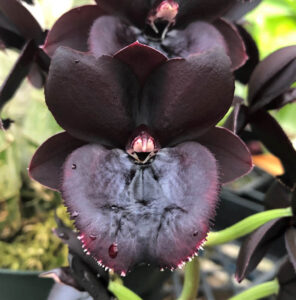
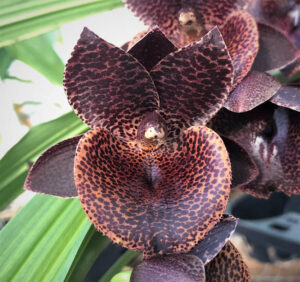
Ctsm. pileatum (25%) + Ctsm. denticulatum (25%) + Morm. ignea (25%) + Ctsm. expansum (19%) = Catamodes Darkonium
An 80 year old friend of Fred’s was skeptical of ever getting an FCC so Fred gave him Catamodes Darkonium ‘Ebony Beauty’….and he got the best FCC of the year.”
Fred says look out for a cross coming soon: Ctmds Darkonium x Ctmds Dragons Tail.
“Don’t forget the name!”
When I asked if he was going to retire anytime soon he said, “Nah, they will find me on the floor cold with a toothpick in my hand.”
References:
https://www.orchids.org/genera/fredclarkeara
http://www.catasetinae.com/gallery-fredclarkeara.htm
https://catasetinaecanada.weebly.com/catamodes-ctmds.html
http://darwin-online.org.uk/EditorialIntroductions/ Freeman_FertilisationofOrchids.html
Comparative anatomy and systematics of Catasetinae (Orchidaceae)
WILLIAM LOUIS STERN FLS* and WALTER S. JUDD
Department of Botany, University of Florida, Gainesville, Florida 32611-8526, USA
Sunset Valley Orchids: www.sunsetvalleyorchids.com
Supplement to October 2022 AOS orchids magazine article by Fred Clarke,
“Hybridisers”
‘Catasetums’ by Fred Clarke http://www.catasetinae.com/
p.346 ORCHIDS MAY 2007 WWW.AOS.ORG
https://www.aos.org/orchid-awards-judging/aos-awards.aspx
URL accessed 17 November 2022

